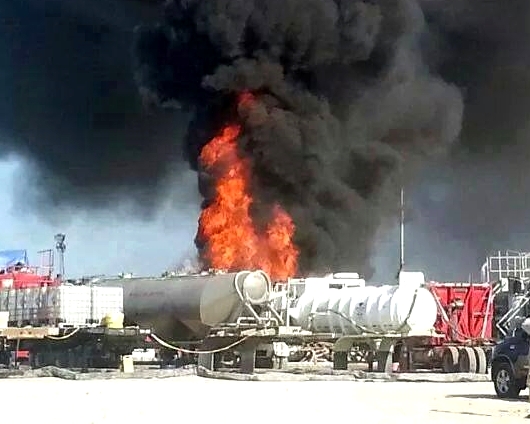How the COVID-19 pandemic can help us understand the fears of communities on the frontlines of oil, gas and mining
Written by Jan Morrill and Leann Leiter
As the effects of COVID-19 spread across the United States, Earthworks staff are, like everyone, gripped by the uncertainty of the global pandemic and the physical and emotional effects of the stress it brings for so many. We also know that many people are coping with this new crisis on top of the constant fear and worry that comes with having dangerous extractive industries next door.
Even before the current public health crisis, communities living near mining and oil and gas projects have been forced to live with these well-founded fears and the toll they take on emotional health and wellbeing.
In the shadow of tailings dams
The mining process creates massive amounts of a waste called tailings–a mixture of crushed rock, chemicals and water–which are often stored behind earthen dams in the form of a wet slurry. Tailings dams have been failing with increasing frequency and severity over the last 100 years. Experts predict 19 catastrophic tailings dam failures between 2018 and 2027 but cannot predict which dam will be next. This means that communities living downstream from tailings dams are left waiting and hoping for the best.
In 2019, a dam near the town of Brumadinho, Brazil collapsed creating an avalanche of sludge that flowed five miles and killed over 270 people. In that same region there are 140 tailings dams classified as “high risk” to people and the environment and four have been designated as at “imminent risk” of failure. Brumadinho was the second dam to collapse in that area in the last 5 years. The Wall Street Journal quoted local residents saying they “spend almost half of their monthly income on tranquilizers, sleeping pills and other medication” because they fear the worst from nearby dams.
In Sonora, Mexico, the mining company Grupo Mexico is expanding a tailings dam at one of its copper mines that is projected to reach up to 600 feet and sprawl over 12 square miles. Community members in Bacanuchi, the first town in the path of a potential spill, are opposed to the dam. They live in a constant state of worry for their safety and whether they will have to flee or lose their homes if the dam collapses.
Pollution pressures
People living next to gas wells and petrochemical complexes or atop pipelines are also plagued with constant worry about their health, land, and their safety.

In the past ten years in the US, pipeline operators reported 6,298 “incidents” — about 1.7 per day on average — resulting in 140 fatalities and the evacuation of over 35,000 residents. Between 2010 and 2018, 1,888 reported gas leaks resulted in “serious injury, fatality or major financial loss.” 2019 alone saw repeated disasters at oil refineries, houses leveled by gas explosions, and catastrophic pipeline failures. There are almost 1.3 million oil & gas facilities in the US, and 12.6 million people live within a mere ½ mile radius of one or more of these hazards, a distance known to increase health risks.
One survivor of the historic 2018 gas well explosion in Powhatan Point, Ohio said that his children now keep bags packed with clothes and toys ready in case the family has to flee. In interviews with Earthworks a few years ago, Pennsylvania residents expressed fear for their children’s health and lack of trust that the government can protect them.
Some Earthworks staff members have lived on the frontlines and felt these fears, too. This blog’s co-author lives three miles from the MarkWest gas processing plant explosion that killed one worker and severely burned others. In gas patches everywhere, the next disaster could happen at any time.
What research shows
Both the current public health crisis and the specter of industrial disaster take a toll on physical and emotional health and create an unabating anxiety that catastrophe is looming.
People living in situations where their “fight or flight” response is continually engaged suffer physiological responses like headaches, lack of energy, problems sleeping, irritability, and mental health disorders (like depression, anxiety, panic attacks, etc).
Research has indicated that residential proximity to industrial activity has a negative impact on mental health directly related to “individuals’ perceptions…of personal powerlessness.” Researchers studying communities in Appalachia also found that women living closest to industrial sites experienced a sense of powerlessness that influenced their health. A 2009 study reported that the perception of risk may be at least as important in predicting poor health outcomes as direct exposure to hazards.
Countering fear with respect
The fear and uncertainty created by the COVID crisis may help us all better understand the stress and powerlessness frontline communities affected by extractive projects confront every day. At Earthworks, we are as committed as ever to taking our lead from communities as they struggle to protect themselves.
Just as we cannot allow the government’s COVID response to create another health crisis by loosening polluter oversight, we cannot allow mining, oil and gas corporations to decide that the loss of human lives is acceptable in their push for profits.
For imperiled communities living with the daily threat of a virus or an industrial disaster, the ask is the same: no one should be treated differently because they live in a “sacrifice zone,” and governments have an obligation to do whatever it takes to protect health and prevent future dangers.
Banner photo: The November 2015 Samarco mine tailings dam failure in Mariana, Minas Gerais, Brazil. Credit: Rogério Alves/TV Senado
